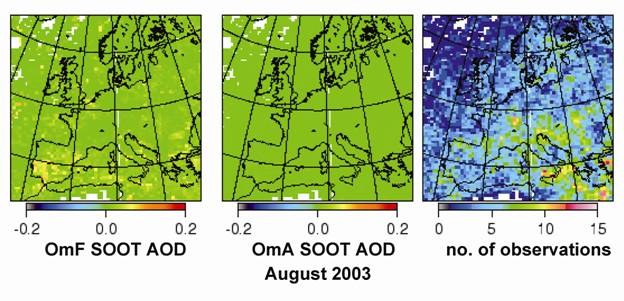Assimilation of satellite aerosol measurements improves quality of forecast of air quality
Both, global and regional chemical transport modelling have successfully included aerosol modules in recent years. Apart from scientific research questions this is motivated mainly by the implications of aerosols on human health and the radiative budget in the atmosphere. While the modelling of physical and chemical processes has improved widely, a specific problem is the timely information of special events with elevated aerosol emissions. Typically, databases show deficiencies in spatial and temporal resolution, quantitative values and their evolution over time. Irregular episodic events like fires or variable sources in transportation or vegetation cannot be modelled on this basis. Additionally, dust source region databases are typically not detailed enough in terms of spatial resolution and mineral dust size distribution. Together with uncertainties in the modelled wind and surface stress fields this results in deficiencies in modelling dust outbreaks as another class of episodic aerosol events.
Modelling of aerosol particles with chemical transport models is still based mainly on static emission databases while episodic emissions cannot be treated sufficiently. Therefore, up to date measurements have to be taken into account using data assimilation methods. Ground measurements often show a confined geographical coverage which is insufficient compared to the typical horizontal aerosol source variability. Satellite-based sensors provide aerosol measurements on a regional or global scale, covering larger areas within a single overpass. To allow the use of satellite measurements, a coupling of chemical mass concentration modelling with satellite-based measurements relying on physical and optical principles has been developed.
It builds on a mapping of aerosol classes used both in observation and model space taking their optical and chemical properties into account. Refractive indices for primary organic carbon particles, anthropogenic particles, and secondary organic species have been defined. Together with a treatment of different size distributions in observations and model state, this allows transforming the background from mass concentrations into aerosol optical depths. A two-dimensional, variational assimilation is applied for component-wise aerosol optical depths. Analysis fields are assessed threefold: (1) through validation against AERONET especially in Saharan dust outbreak situations, (2) through comparison with the British Black Smoke and Sulphur Dioxide Network for soot-containing particles, and (3) through comparison with measurements of the water soluble components SO4, NH4, and NO3 conducted by the EMEP (European Monitoring and Evaluation Programme) network. Separately, for the water soluble, the soot and the mineral dust aerosol components a bias reduction and subsequent a root mean square error reduction is observed in the analysis for a test period from July to November 2003. Additionally, examples of an improved analysis during wildfire and dust outbreak situations have been demonstrated.

